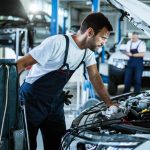The construction industry has been experiencing a significant transformation in recent years, largely driven by advancements in automotive technology.
From autonomous vehicles to electric powertrains, innovations originally developed for automobiles are now reshaping the landscape of construction machinery.
In addition to autonomous vehicles and electric powertrains, innovations such as telematics, GPS tracking, and predictive maintenance software are also being integrated into construction machinery, enhancing equipment performance, reducing downtime, and optimizing project management workflows.
This article explores the ways in which automotive advancements are defining modern construction equipment, and revolutionizing efficiency, safety, and sustainability in the sector.
The Progression of Automotive Innovation within Construction Equipment
The integration of telematics and the Internet of Things (IoT) is a notable trend in construction machinery. These systems, akin to those in modern vehicles, facilitate real-time monitoring of equipment performance, precise location tracking, and proactive maintenance scheduling.
Leveraging data analytics, construction firms optimize fleet management, slash operational costs, and heighten project efficiency and safety through informed decision-making and predictive maintenance strategies.
Integration of Telematics and IoT
One of the most notable advancements borrowed from automotive technology is the integration of telematics and the Internet of Things (IoT) in construction machinery. You can also navigate this site trueagturf.com if you want to get more information about construction machinery.
Telematics systems, similar to those found in modern cars, allow for real-time monitoring of equipment performance, location tracking, and predictive maintenance scheduling.
By harnessing IoT capabilities, construction companies can optimize fleet management, reduce downtime, and enhance overall productivity.
Adoption of Hybrid and Electric Powertrains
In response to growing environmental concerns and stricter emissions regulations, construction machinery manufacturers are increasingly turning to hybrid and electric powertrains.
Much like the automotive industry’s shift towards electrification, construction equipment is benefitting from reduced emissions, lower operating costs, and quieter operations.
Electric excavators, bulldozers, and loaders are becoming more prevalent on construction sites, offering sustainable alternatives to their diesel-powered counterparts.
Impact on Efficiency and Productivity
Automotive-inspired advancements are driving significant improvements in the efficiency and precision of modern construction machinery.
Advanced sensors, GPS navigation systems, and onboard computers enable more precise control of equipment, resulting in faster project completion times and higher-quality work
Enhanced Performance and Precision
Automotive business inspired the driving significant improvements in the efficiency and precision of modern construction machinery.
Advanced sensors, GPS navigation systems, and onboard computers enable more precise control of equipment, resulting in faster project completion times and higher-quality work.
Autonomous features, such as semi-autonomous grading systems and robotic arms, further enhance productivity by reducing the need for manual labor and minimizing human error.
Optimized Fuel Consumption and Maintenance
The integration of hybrid and electric powertrains in construction machinery is revolutionizing fuel consumption and maintenance practices.
Electrically powered equipment not only reduces greenhouse gas emissions but also offers lower fuel costs and simplified maintenance requirements.
Additionally, telematics systems provide valuable data insights that enable proactive maintenance scheduling, minimizing unplanned downtime and maximizing operational uptime.
Advancements in Safety and Operator Comfort
Automotive-inspired advancements are driving improvements in safety features for construction machinery. Collision avoidance systems, adaptive cruise control, and 360-degree camera systems help operators navigate complex worksites more safely and efficiently.
Additionally, advancements in artificial intelligence (AI) and machine learning enable predictive analytics for identifying potential hazards and preventing accidents before they occur.
Intelligent Safety Systems
Automotive advancements are also driving improvements in safety features for construction machinery. Collision avoidance systems, adaptive cruise control, and 360-degree camera systems help operators navigate complex worksites more safely and efficiently.
Moreover, advancements in artificial intelligence (AI) and machine learning enable predictive analytics for identifying potential hazards and preventing accidents before they occur.
Ergonomic Design and Operator Assistance
Modern construction equipment is increasingly designed with operator comfort and assistance in mind, drawing inspiration from automotive interiors.
Ergonomically designed cabins, adjustable seating, and intuitive controls enhance operator comfort and reduce fatigue during long hours of operation.
Additionally, features such as automatic bucket leveling and integrated guidance systems assist operators in performing tasks more accurately and efficiently.
The Future of Automotive-Inspired Construction Machinery
The future of automotive and construction technology is expected to accelerate, driving further innovation and integration in construction machinery.
Advancements in autonomous driving, electrification, and connectivity will redefine the capabilities and performance standards of construction equipment.
Continued Innovation and Integration
Looking ahead, the convergence of automotive and construction technology is expected to accelerate, driving further innovation and integration in construction machinery.
Advancements in autonomous driving, electrification, and connectivity will continue to redefine the capabilities and performance standards of construction equipment.
Furthermore, partnerships between automotive and construction industry players are likely to foster cross-disciplinary collaboration and spur the development of groundbreaking solutions.
Sustainable Practices and Environmental Responsibility
As sustainability becomes an increasingly critical consideration in construction practices, automotive-inspired advancements will play a pivotal role in promoting environmental responsibility.
The transition towards electric and hybrid construction machinery will not only reduce carbon emissions but also minimize noise pollution and mitigate the ecological impact of construction activities.
Furthermore, the adoption of circular economy principles, such as remanufacturing and recycling, will further enhance the sustainability of construction equipment throughout its lifecycle.
Conclusion
Automotive advancements are profoundly reshaping the landscape of modern construction machinery, driving improvements in efficiency, safety, and sustainability.
As technology continues to evolve, the future of construction machinery looks increasingly connected, autonomous, and environmentally conscious, promising a more efficient, safer, and greener built environment for generations to come.













